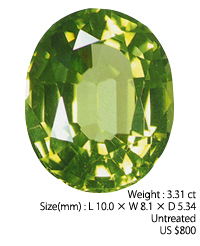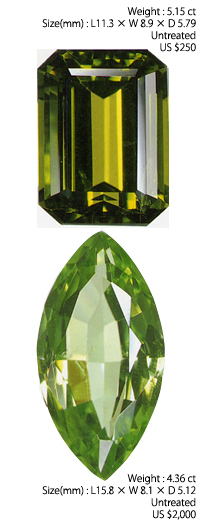CHARACTEROSTOCS BY COUNTRY OF ORIGIN
The historical source of Zabargad produces very little peridot now; current producers include Arizona in the United States, Myanmar, and Norway, as well as Brazil, China, and Kenya. As the photographs show, peridot from each source has its own characteristic hue. Like emerald, it may be that peridot requires a separate quality scale for each source. However, since it is not a very rare gem, here they are combined into one scale. |
 |
Myanmar (formerly Burma)
Burmese peridot comes from near Mogok, a famous source of ruby. Large material of over 10 carats is recovered there. As the photograph shows, material from Myanmar has an attractive, slightly olive-colored green with little brownness. This stone has been recut to improve its proportions and finish, showing an attractive mosaic-like pattern created by the various tones of color. |
|
Arizona (United States)
Arizona produces very large quantities, but most of these stones have a brownish or blackish color and are less than 5 carats, so they are used as inexpensive accessories. However, some attractive green stones may be found, and it cannot be said that all are of low quality. Please note the difference in the hues between the Arizona, Myanmar, and Norway material. Rarity differs noticeably between sources, especially in gem qualities, influencing value and price. |
 |
Norway
Peridot from sondmore, Norway, is a light but pure green. Peridot from Myanmar cannot compare with this material. One can see how greatly purity and saturation of color, and especially transparency, influence the beauty of a gemstone, much more so that tone. Also, it is important for color to be distributed in abundance throughout the stone instead of in patches, and for the stone to have a good shape and appearance. |
|
 |
JUDGING QUALITY
When the quality scale is applied to peridot from various sources, we see material from Myanmar falling in grades S and A, and Arizona material in grade C. Also, Arizona yields few stones larger than 5 carats, while Myanmar produces large stones. Large Burmese stones are often poorly cut, with imperfections, but many of these can be recut into attractive S-quality stones.
The key in judging the quality of peridot is the degree of brownness in the color and the degree of imperfections in the stone. These will decide the beauty grade.
|
| |
|